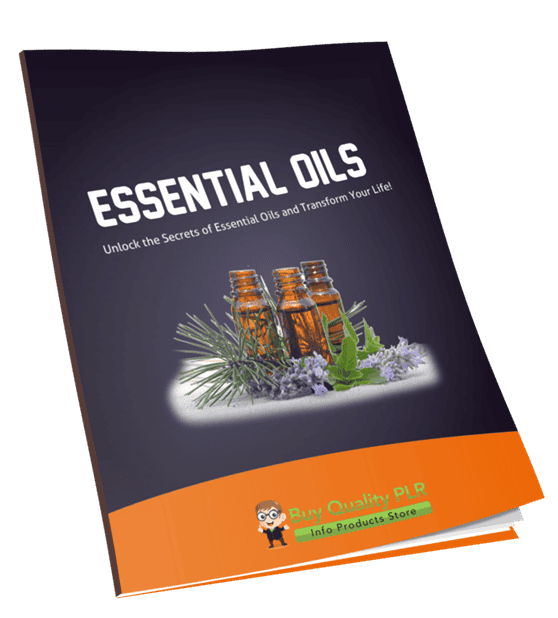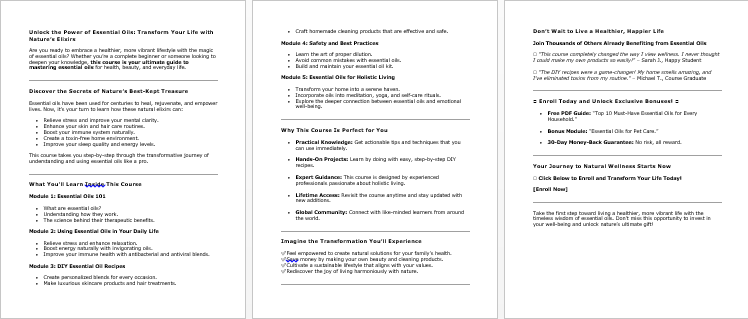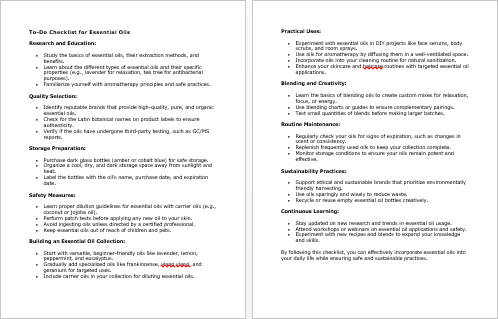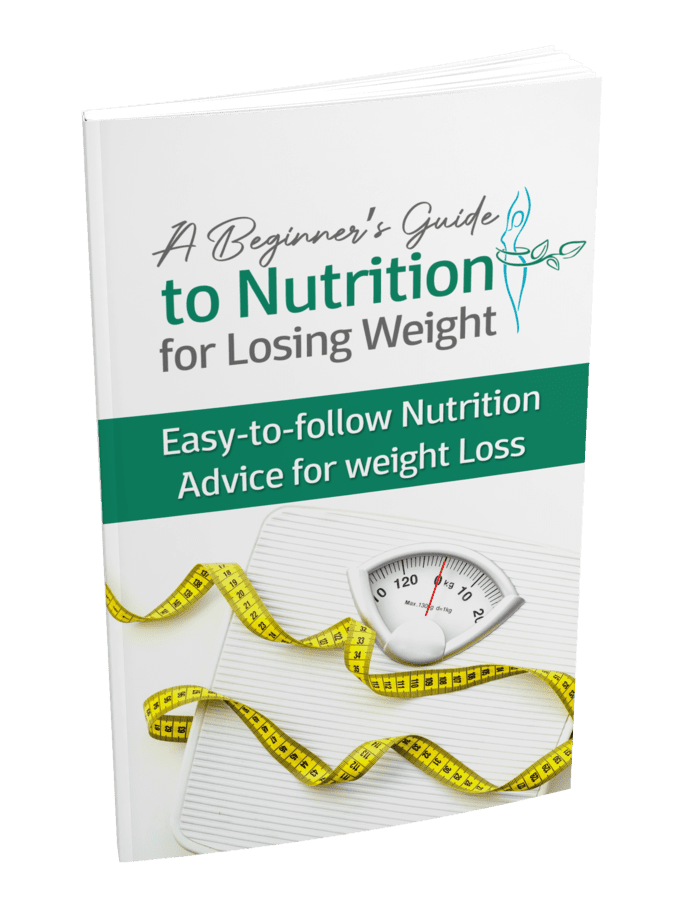
Essential Oils PLR Course 25k Words
in Healing PLR , Health PLR , Health PLR eBooks , PLR Checklists , PLR eBooks , PLR eCourses , PLR List Building Reports , Premium PLR , Premium PLR eBooks , Premium PLR Reports , Premium White Label Brandable PLR Coaching Courses , Private Label Rights Products , Wellness PLR , Wellness PLR eBooksChoose Your Desired Option(s)
has been added to your cart!
have been added to your cart!
#essentialoilscourse #essentialoilbenefits #plrcontent #healthandwellness #aromatherapytips #essentialoilguide #wellnesseducation #naturalliving
Unlock the Secrets of Essential Oils and Transform Your Life!
Dive into the fascinating world of essential oils with the Essential Oils PLR Course. This comprehensive guide will empower you to use essential oils safely and effectively to enhance your health, well-being, and daily routines.
Presenting…
Essential Oils PLR Course 25k Words
What’s Inside the Essential Oils Course?
Module 1: Introduction to Essential Oils
Start with the basics and build a strong foundation for your essential oil journey.
- What Are Essential Oils? Understand their origins and therapeutic properties.
- Benefits of Essential Oils: Discover how they can improve your health, reduce stress, and boost your immune system.
- How They Work: Learn the science behind essential oils and how they interact with your body.
- Safety Guidelines: Master the dos and don’ts of using essential oils safely and effectively.
Module 2: Essential Oils for Wellness
Transform your health with targeted essential oil applications.
- Stress Relief: Relax with calming oils like Lavender and Chamomile.
- Energy Boost: Revitalize your day with Peppermint and Lemon oils.
- Immune Support: Protect your health with Eucalyptus and Tea Tree.
- Better Sleep: Rest easy with soothing oils like Bergamot and Ylang Ylang.
Module 3: DIY Essential Oil Recipes
Get creative with simple, effective recipes for everyday use.
- Custom Blends: Craft your unique essential oil combinations.
- DIY Face Serum: Nourish your skin with Rosehip and Frankincense oils.
- Body Scrubs: Exfoliate and energize with Grapefruit and Eucalyptus oils.
- Room Sprays: Freshen your home with Lemon and Lavender blends.
Module 4: Essential Oils in Everyday Life
Incorporate essential oils into your daily routines for a healthier, more natural lifestyle.
- Natural Cleaning: Sanitize your home with Tea Tree and Lemon oils.
- Hair Care: Improve hair growth and scalp health with Rosemary oil.
- Skin Care: Treat acne, dryness, and more with Tea Tree and Geranium oils.
- Bathing Routines: Create a spa-like experience with oils in your bath.
Module 5: Buying, Storing, and Caring for Essential Oils
Ensure your oils last and remain effective.
- Choosing Quality Oils: Learn to identify pure, high-quality essential oils.
- Proper Storage: Keep your oils potent with proper storage techniques.
- Understanding Expiration: Know when your oils are past their prime.
- Creating Your Oil Kit: Build a collection tailored to your needs.
Who Can Benefit from This Course?
- Wellness Enthusiasts: Learn to incorporate essential oils into your health and wellness routines.
- Small Business Owners: Use the content to create workshops, guides, or products.
- Coaches and Trainers: Add value to your offerings with ready-made essential oil lessons.
- Content Creators: Publish blogs, videos, or courses using this high-quality PLR content.
What’s Included in the PLR Package?
- Essential Oils Course (22,414 words): Comprehensive modules covering everything you need to know about essential oils.
- Checklist (413 words): A quick reference guide for applying what you’ve learned.
- FAQs (935 words): Expert answers to common questions about essential oils.
- Sales Page (533 words): Professionally written content to help you market the course.
How to Use and Profit from This Course
- Sell It as a Standalone Product
Offer it as a premium course priced between $47 and $97. - Bundle It with Other Products
Combine it with wellness, skincare, or DIY courses to create an irresistible package. - Create Membership Content
Offer the course as part of a subscription plan for ongoing revenue. - Host Workshops or Classes
Use the course content to run live or recorded workshops. - Use as Lead Magnet Content
Offer excerpts as free downloads to grow your email list. - Rebrand and Resell
Customize the content to reflect your brand and market it as your own.
Why Choose This PLR Course?
- High-Quality Content: Professionally written and ready to use.
- Flexible Applications: Create blogs, videos, eBooks, courses, and more.
- Time-Saving: Start using or selling the content immediately.
- Customizable: Edit and rebrand to match your unique style.
Limited-Time Offer: Own the Essential Oils PLR Course for Just $14.99!
Don’t miss this chance to tap into the growing essential oils niche. Empower yourself—or your audience—with the tools to live a healthier, more natural life.
has been added to your cart!
have been added to your cart!
Here A Sample of Essential Oilse PLR Course
Welcome to the Essential Oils training course! Whether you’re new to essential oils or looking to enhance your knowledge, this course will guide you through everything you need to know to start using essential oils safely and effectively in your daily life. Let’s dive in and explore the amazing world of essential oils together!
Module 1: Introduction to Essential Oils
Step 1: What Are Essential Oils?
Welcome to the first step in your journey to understanding essential oils! This section will guide you through the basics of essential oils, offering a comprehensive introduction to what they are, how they’re made, and their powerful properties. Essential oils are much more than pleasant fragrances; they are potent plant extracts that have been used for centuries for their therapeutic, medicinal, and cosmetic benefits. Let’s break it down step-by-step.
1.1: The Basics of Essential Oils
Essential oils are natural, concentrated plant extracts that capture the true essence of the plant from which they are derived. Unlike other plant-based products, such as teas or tinctures, essential oils are highly concentrated forms of plant compounds that retain the full range of the plant’s therapeutic properties. These oils are typically extracted using distillation methods, which involve steam or heat to separate the oil from the plant’s physical material.
Each essential oil carries a distinct scent and has specific uses depending on the plant from which it is derived. The therapeutic properties of these oils can range from mood-boosting and calming to healing and invigorating, depending on the oil and how it’s used.
1.2: The Extraction Process – Distillation
The most common method used to extract essential oils is distillation. This process separates the essential oil from the plant material using steam. The steam helps release the essential oils from the plant’s cells, which are then captured and condensed into liquid form. There are two primary types of distillation:
- Steam Distillation: This is the most popular and efficient method. Plant material, such as flowers, leaves, or roots, is placed in a still (distillation unit) and exposed to steam. As the plant material heats up, the essential oils are released into the steam, which is then cooled and condensed back into liquid form.
- Cold Press Extraction: This method is typically used for citrus oils (like lemon or orange). The peel of the fruit is mechanically pressed to extract the essential oils.
During the distillation process, the temperature and pressure must be carefully controlled to preserve the quality and potency of the essential oils.
1.3: Where Essential Oils Come From – Plant Sources
Essential oils are derived from various parts of plants, each offering unique benefits. The plant material used in the extraction process depends on the type of plant and the properties that are desired from the essential oil. Here are the most common parts of the plant used to create essential oils:
- Flowers: Many essential oils are extracted from the blossoms of plants. For instance, Lavender oil comes from lavender flowers, and Rose oil is derived from rose petals. Flower-based oils are often used for their calming, uplifting, and soothing properties.
- Leaves: The leaves of certain plants provide a rich source of essential oils. For example, Peppermint oil is extracted from the leaves of the peppermint plant, while Eucalyptus oil is taken from the leaves of the eucalyptus tree. Leaf oils are often refreshing, cooling, and energizing.
- Bark: The bark of trees like Cinnamon provides essential oils known for their warm, spicy aroma and antibacterial properties. Sandalwood oil is another example, known for its calming and grounding effects.
- Roots: Some essential oils are extracted from the roots of plants. For example, Ginger essential oil is derived from the root of the ginger plant, and Vetiver oil comes from the roots of the vetiver grass. Root oils tend to have deep, earthy aromas and are often used for grounding and stabilizing effects.
- Seeds and Resins: Certain essential oils, such as Carrot Seed oil and Frankincense oil, are extracted from seeds or resins. These oils tend to have rich, woody, and earthy scents, and they offer a variety of therapeutic uses, from skin care to emotional well-being.
1.4: The Therapeutic Properties of Essential Oils
One of the most remarkable qualities of essential oils is their ability to support physical and emotional well-being. Essential oils carry the natural, therapeutic compounds of the plants they come from, which are believed to have various benefits for the body, mind, and spirit. Here are some of the key therapeutic properties:
- Aromatherapy: The practice of using essential oils to improve emotional and physical health through inhalation is known as aromatherapy. When inhaled, essential oils can affect the limbic system in the brain, which controls emotions, memory, and behavior. This is why essential oils are often used for stress relief, mood enhancement, and mental clarity.
- Antimicrobial Properties: Many essential oils, such as Tea Tree and Oregano, are known for their strong antimicrobial properties. These oils can help fight bacteria, fungi, and viruses, making them useful for cleaning, disinfecting, and supporting immune health.
- Relaxation and Stress Relief: Essential oils like Lavender, Chamomile, and Bergamot are renowned for their calming effects, often used to promote relaxation, reduce anxiety, and improve sleep.
- Pain Relief and Inflammation: Certain essential oils, such as Peppermint, Eucalyptus, and Ginger, are used to relieve pain and reduce inflammation. These oils can be applied topically (with proper dilution) or used in a diffuser to help ease muscle aches, headaches, and joint pain.
- Skin Care: Essential oils like Tea Tree, Frankincense, and Rose are often used in skin care to treat acne, reduce scars, and promote a healthy, glowing complexion.
1.5: Uses of Essential Oils in Daily Life
Essential oils are incredibly versatile and can be used in various ways in your daily life. Here are some common applications:
- Aromatherapy: The most popular use for essential oils is in aromatherapy, where the oils are inhaled through diffusers, steam inhalation, or even simple direct inhalation. This method helps support emotional health and can improve concentration, relaxation, and mood.
- Topical Application: Essential oils can be applied to the skin, but only after they are properly diluted with a carrier oil like coconut, jojoba, or almond oil. These oils can be used for skin care, hair care, and muscle pain relief.
- Cleaning: Many essential oils, such as Lemon, Tea Tree, and Eucalyptus, have antimicrobial properties and can be used in natural cleaning products. They help sanitize surfaces, neutralize odors, and create a fresh-smelling home environment.
- Massage: Essential oils are often used in massage therapy to relieve tension, ease pain, and promote relaxation. The oils can be diluted with a carrier oil for safe topical use.
- Bathing: Adding a few drops of essential oil to your bath can enhance relaxation, relieve stress, or soothe sore muscles, depending on the oil used.
Conclusion
Essential oils are far more than just pleasant scents; they are powerful plant-based extracts that offer numerous therapeutic benefits. From their extraction from various plant parts to their ability to support health and well-being, essential oils play a vital role in modern holistic health practices. By understanding what essential oils are, how they’re made, and their various uses, you’re beginning an exciting journey into the world of natural wellness. As we move forward in this course, we’ll explore how to use these oils safely and effectively, so you can enjoy their many benefits in your daily life.
Step 2: Understanding the Benefits of Essential Oils
Welcome to Step 2 of your course on essential oils! In this section, we will dive deep into the many benefits that essential oils can offer to your health, emotional well-being, and overall quality of life. Essential oils have been used for centuries in various cultures for their therapeutic properties, and today, they are an essential part of holistic health practices worldwide. Let’s take a step-by-step look at how these natural extracts can improve your health, reduce stress, and boost your well-being.
2.1: The Role of Essential Oils in Health and Wellness
Essential oils are known to have a wide range of beneficial effects on the body, from promoting relaxation and reducing stress to supporting the immune system and improving skin health. Each essential oil carries its own unique set of properties, making them useful for various therapeutic purposes. The primary benefit of using essential oils is their ability to interact with the body’s systems—whether through the skin, the respiratory system, or by inhalation—to enhance physical, mental, and emotional health.
Essential oils work in several ways to promote wellness:
- Aromatherapy: The most common form of essential oil therapy, which involves inhaling the oils to improve emotional and physical well-being.
- Topical Application: Essential oils are often diluted and applied to the skin, where they can absorb into the bloodstream to provide targeted relief for specific ailments or conditions.
- Massage Therapy: Used in combination with massage, essential oils can help relieve muscle tension and promote relaxation.
Now, let’s explore the specific benefits that essential oils can provide.
2.2: Essential Oils for Reducing Stress and Promoting Relaxation
One of the most widely known and celebrated benefits of essential oils is their ability to reduce stress and promote relaxation. The power of scent to influence our mood and emotions has long been documented, and essential oils harness this natural ability to help us unwind, de-stress, and find peace in our busy lives.
- Lavender: Widely known for its calming and soothing properties, lavender essential oil is often used to relieve anxiety, promote restful sleep, and calm an overactive mind. It is commonly used in aromatherapy to create a relaxing environment and reduce feelings of stress or tension.
- Chamomile: With its sweet, floral scent, chamomile essential oil is another favorite for relaxation. It has a calming effect on the nervous system and is often used to reduce feelings of anxiety or agitation.
- Bergamot: Known for its uplifting citrus scent, bergamot essential oil helps to balance emotions. It is often used to combat symptoms of depression and anxiety, offering both relaxation and emotional support.
- Frankincense: This grounding oil has been used for centuries in meditation and spiritual practices. It is believed to have stress-relieving properties and can create a tranquil environment to promote mental clarity and calmness.
These oils can be used in diffusers, applied to pulse points, or added to baths to reduce stress and encourage a peaceful state of mind.
2.3: Boosting the Immune System with Essential Oils
Essential oils have long been used to support and strengthen the immune system. Many essential oils possess antiviral, antibacterial, antifungal, and antiseptic properties, making them powerful tools in preventing illness and supporting the body’s natural defenses.
- Eucalyptus: Known for its antimicrobial properties, eucalyptus essential oil is often used to clear respiratory pathways, relieve congestion, and support overall immune function. It can be inhaled directly, added to steam, or applied topically to the chest to help fight off colds and flu.
- Tea Tree: Famous for its potent antibacterial and antiviral effects, tea tree oil is a common remedy for skin infections, acne, and colds. It helps cleanse the body by fighting harmful pathogens, making it a go-to oil for immune support.
- Lemon: Lemon essential oil has strong antiseptic properties and is used to cleanse and detoxify the body. It can be diffused or applied topically to help fight bacteria and viruses, and it also acts as a natural disinfectant in cleaning products.
- Oregano: Oregano oil is one of the most potent essential oils for boosting immune function. It is often used to combat infections and prevent the spread of illness, as it contains powerful antimicrobial and antifungal compounds.
These oils can be incorporated into your daily routine to support your immune system. Diffusing them in the air, applying them topically (when diluted), or adding them to a wellness roller can help strengthen your body’s defenses.
2.4: Enhancing Mental Clarity and Focus
Essential oils are also known to improve cognitive function, boost concentration, and enhance mental clarity. Whether you’re studying, working, or simply trying to stay productive, certain essential oils can help you stay focused and clear-headed.
- Peppermint: A favorite for mental clarity, peppermint essential oil has an invigorating and energizing effect. It helps improve concentration and memory, making it perfect for use during work or study sessions. It can also relieve mental fatigue and provide an immediate energy boost when you’re feeling tired or sluggish.
- Rosemary: Known for enhancing memory and cognitive function, rosemary essential oil is often used to increase alertness and sharpen focus. It is believed to stimulate the brain and improve mental clarity, making it an excellent oil for productivity.
- Lemon: As well as boosting the immune system, lemon oil is also known for improving mood and mental clarity. It can help clear the mind and reduce mental fog, making it easier to stay focused on tasks.
- Basil: Often used to support mental clarity, basil essential oil helps to reduce stress while improving focus and mental alertness. It is particularly helpful when you’re feeling overwhelmed or mentally fatigued.
Using these oils in a diffuser or applying them to your temples and neck can help improve your ability to concentrate and stay focused, making them great for both work and study.
2.5: Essential Oils for Skin Health and Anti-Aging
Essential oils have a long history of being used for skin care, offering benefits such as healing, rejuvenation, and anti-aging effects. Their natural properties can help improve the appearance of the skin, reduce wrinkles, and even treat conditions like acne, eczema, and dryness.
- Tea Tree: As mentioned earlier, tea tree oil is an excellent remedy for acne, thanks to its antibacterial properties. It helps to cleanse the skin, reduce inflammation, and prevent new breakouts.
- Frankincense: Known for its rejuvenating properties, frankincense oil is widely used in skin care for its ability to reduce wrinkles and fine lines. It can help promote the regeneration of healthy skin cells, leaving the skin looking youthful and smooth.
- Geranium: Geranium oil is used for balancing skin oils and improving skin texture. It can help with skin conditions like acne, eczema, and dryness by promoting healthy skin regeneration.
- Lavender: In addition to its calming properties, lavender oil has been shown to aid in skin repair. It can reduce the appearance of scars, prevent acne, and promote the healing of minor burns and cuts.
Essential oils can be added to your skincare routine by diluting them in a carrier oil and applying them directly to the skin, or by using them in DIY face masks, creams, and serums. These oils can provide a natural, non-toxic way to enhance your skin’s health and appearance.
2.6: Conclusion
Understanding the many benefits of essential oils opens up a world of possibilities for improving your overall health and well-being. From reducing stress and anxiety to boosting your immune system and enhancing mental clarity, essential oils are powerful tools in supporting a healthy lifestyle.
By incorporating essential oils into your daily routine, you can experience their natural therapeutic effects, which support not just your physical health but also your emotional balance and mental clarity. As you continue exploring essential oils, remember that their versatility is one of their greatest assets, and with the right knowledge, you can use them effectively to improve your life in many ways.
In the next step of this course, we will look at how to safely use essential oils and understand the best methods of application to maximize their benefits.
Step 3: How Essential Oils Work
In Step 3 of your essential oils course, we will explore the science behind how essential oils work. Understanding the mechanisms through which essential oils interact with the body and mind is crucial for their effective use in health, wellness, and therapeutic practices. From the way their aroma affects the brain to how they interact with the skin, essential oils have a profound impact on both our physical and emotional states. This section will break down these processes step by step, giving you a clear understanding of how essential oils influence the body and mind.
3.1: The Science of Essential Oils – What Makes Them So Powerful?
Essential oils are highly concentrated plant extracts derived from flowers, leaves, roots, or bark. Their strength lies in the chemical compounds that they contain, such as terpenes, aldehydes, esters, and phenols. These compounds are responsible for the therapeutic properties that essential oils are known for. For example:
- Terpenes: Found in oils like eucalyptus and lemon, terpenes help fight infections and inflammation.
- Phenols: These compounds, which are present in oils such as clove and oregano, have powerful antimicrobial and antioxidant effects.
- Aldehydes and Esters: Present in oils like lavender and chamomile, these compounds contribute to relaxation and stress relief by calming the nervous system.
These naturally occurring chemical compounds are absorbed by the body when essential oils are inhaled or applied to the skin. They have the ability to influence bodily systems and trigger positive responses in the body’s nervous, immune, and hormonal systems.
3.2: The Role of Smell in How Essential Oils Affect the Body and Mind
One of the most fascinating ways in which essential oils work is through the sense of smell. When you inhale the scent of essential oils, the molecules in the oil travel through the air and are absorbed by the olfactory receptors in your nose. This triggers a complex reaction in your brain, which has both immediate and long-lasting effects on your mind and body.
Here’s a step-by-step breakdown of how this process occurs:
- Inhalation of Essential Oil Molecules: When you breathe in the scent of an essential oil, the molecules travel through the nasal passages and into the olfactory system, which is directly connected to the brain.
- Olfactory Receptors Stimulate the Limbic System: The olfactory receptors in the nose send signals to the limbic system of the brain, which is responsible for regulating emotions, memory, and behavior. The limbic system is also closely linked to the hypothalamus, which controls functions like heart rate, blood pressure, and stress levels.
- Emotional and Physiological Responses: As the olfactory system stimulates the limbic system, various emotional and physiological responses occur. For example, inhaling lavender oil may reduce stress and promote relaxation by signaling the brain to release calming hormones like serotonin and melatonin.
- Memory and Mood Enhancement: The limbic system is also responsible for memory, which is why scents can trigger vivid memories and emotions. This explains why certain scents, like rose or jasmine, may evoke feelings of happiness, love, or calm.
This powerful connection between smell and emotional regulation is why aromatherapy with essential oils is so effective for managing stress, anxiety, and even improving sleep.
3.3: How Essential Oils Work Through Topical Application
While inhalation is the most common method for using essential oils, applying them topically is another way they interact with the body. When essential oils are applied to the skin, they can penetrate the outer layers and reach the bloodstream, where they have therapeutic effects on specific areas of the body.
Here’s how topical application works step by step:
- Absorption into the Skin: Essential oils are absorbed through the skin when they are applied, usually diluted in a carrier oil such as coconut or jojoba oil. The molecules in the essential oils pass through the skin’s outer layers and into the bloodstream.
- Interaction with the Circulatory System: Once in the bloodstream, the compounds from the essential oils circulate throughout the body, where they can exert their therapeutic effects on various systems. For example, peppermint oil, applied to the temples, can help relieve headaches by improving circulation and reducing tension.
- Targeted Effects: Topical application is particularly effective for addressing localized issues. If you have sore muscles, essential oils like eucalyptus or rosemary can be applied to the affected area to relieve pain and inflammation.
- Enhanced Detoxification: Certain essential oils, such as grapefruit and lemon, are known for their detoxifying properties. When applied to the skin, these oils can help support the body’s natural detoxification processes by stimulating lymphatic drainage and improving circulation.
Topical application is an excellent method for using essential oils for specific conditions, such as joint pain, skin irritation, or muscle tension. However, it’s important to always dilute essential oils with a carrier oil to prevent irritation.
3.4: The Biochemical Effects of Essential Oils on the Body
The therapeutic effects of essential oils are largely attributed to the biochemical interactions between the plant compounds and the body. Each essential oil contains unique combinations of compounds that can influence the body’s systems in different ways. When these compounds enter the bloodstream, they can influence the central nervous system, the immune system, and even hormones.
Here’s a deeper look at the biochemical effects of essential oils:
- Impact on the Nervous System: Many essential oils, such as lavender, chamomile, and frankincense, have calming effects on the nervous system. These oils work by interacting with neurotransmitters and receptors in the brain to reduce stress, promote relaxation, and even improve sleep.
- Immune System Support: Essential oils like tea tree, eucalyptus, and oregano are known for their antimicrobial and antiviral properties. These oils stimulate the immune system, helping the body fight off infections and diseases. By enhancing the activity of white blood cells, essential oils support the body’s natural defense mechanisms.
- Hormonal Balance: Some essential oils, such as clary sage, are known to support hormonal balance, particularly in women. These oils can help regulate menstrual cycles, alleviate symptoms of PMS, and even promote healthy skin.
- Digestive Support: Certain essential oils, such as peppermint and ginger, have been shown to aid digestion. These oils help to relax the muscles of the digestive tract, reduce bloating, and alleviate discomfort from indigestion or nausea.
Understanding the biochemical effects of essential oils on the body can help you select the right oils for specific health concerns. Whether you want to reduce stress, improve your immune system, or support digestion, the right essential oils can work wonders when used properly.
3.5: How to Maximize the Benefits of Essential Oils
To ensure that you are getting the maximum benefits from essential oils, it’s important to use them correctly. Here are a few tips on how to optimize their effects:
- Use High-Quality Essential Oils: The quality of the essential oil you use plays a significant role in its effectiveness. Always opt for pure, organic, and therapeutic-grade oils to ensure you’re receiving the highest quality and most potent benefits.
- Proper Dilution: Essential oils are highly concentrated and should always be diluted with a carrier oil when applied topically. This helps to prevent irritation and ensures safe use.
- Correct Application Method: Depending on your needs, choose the best method of application. For emotional or mental wellness, inhalation through a diffuser or direct inhalation may be most effective. For physical ailments, topical application is usually the best method.
- Consistent Use: Like any natural remedy, essential oils work best when used consistently. Incorporate them into your daily routine to experience long-term benefits, whether through aromatherapy, massage, or skincare routines.
By understanding the science behind how essential oils work, you can use them with greater confidence and precision, enhancing both your physical and mental well-being. In the next step of the course, we will explore how to blend essential oils for different therapeutic purposes, allowing you to customize your essential oil experience.
Step 4: Safety First: Using Essential Oils Safely
When incorporating essential oils into daily life, safety is of utmost importance. Essential oils are powerful plant extracts, and while they offer many benefits, improper use can lead to adverse effects. This step emphasizes the key safety principles that ensure you harness their benefits effectively while minimizing risks. The following step-by-step guide will help you and your learners understand the importance of safe dilution, appropriate application methods, and recognizing situations where essential oils should be used with caution.
4.1: Understanding the Importance of Dilution
Essential oils are highly concentrated and potent. Direct application to the skin without proper dilution can lead to irritation, sensitivity, or even chemical burns. Dilution involves mixing essential oils with a carrier oil to ensure safe application.
Step-by-Step Process for Dilution:
- Choose a Carrier Oil: Carrier oils like coconut oil, jojoba oil, almond oil, or olive oil are excellent choices. These oils not only dilute the essential oil but also provide additional nourishment for the skin.
- Know the Safe Dilution Ratio: For adults, a common dilution is 2-3% (2-3 drops of essential oil per teaspoon of carrier oil). For children, elderly individuals, or those with sensitive skin, use a 1% dilution (1 drop per teaspoon).
- Test for Sensitivity: Before full application, perform a patch test. Apply a small amount of diluted oil to a discreet area of skin and wait 24 hours to check for any reactions.
- Adjust as Needed: If you notice any irritation during use, discontinue immediately and adjust the dilution ratio for future applications.
By adhering to these dilution guidelines, you can safely enjoy the benefits of essential oils without risking adverse effects.
4.2: Proper Application Methods
Using essential oils effectively involves selecting the right application method based on your intended outcome. Common methods include inhalation, topical application, and, in some cases, internal use. Each method requires careful consideration to ensure safety.
Step-by-Step Application Guide:
- Inhalation:
- Direct Inhalation: Add 1-2 drops of essential oil to a tissue or your palms, hold it close to your nose, and breathe deeply. This is ideal for quick stress relief or respiratory support.
- Diffusion: Use an essential oil diffuser to disperse the oil into the air. Add 3-5 drops of essential oil per 100 mL of water, depending on the diffuser’s capacity.
- Steam Inhalation: For sinus congestion, add 2-3 drops of essential oil to a bowl of hot water, cover your head with a towel, and inhale deeply. Keep your eyes closed to avoid irritation.
- Direct Inhalation: Add 1-2 drops of essential oil to a tissue or your palms, hold it close to your nose, and breathe deeply. This is ideal for quick stress relief or respiratory support.
- Topical Application:
- Localized Use: Apply diluted essential oil directly to the desired area, such as temples for headaches or wrists for relaxation.
- Massage: Blend the essential oil with a carrier oil and use it for a soothing massage. This is great for muscle pain or stress relief.
- Avoid Sensitive Areas: Never apply essential oils to the eyes, inside the ears, or on broken skin.
- Localized Use: Apply diluted essential oil directly to the desired area, such as temples for headaches or wrists for relaxation.
- Internal Use (Only When Recommended by a Professional):
- Some essential oils, like lemon or peppermint, can be ingested in small amounts, but this should only be done under the guidance of a qualified aromatherapist or healthcare provider.
Selecting the proper method of application ensures that you achieve your desired results safely and effectively.
4.3: Recognizing When and How to Use Essential Oils Safely
Not all essential oils are suitable for everyone or every situation. Special considerations must be made for individuals with certain health conditions, pregnant or nursing women, and young children.
Step-by-Step Safety Considerations:
- Know the Contraindications:
- Certain oils, like rosemary or sage, should be avoided by individuals with high blood pressure or epilepsy.
- Pregnant women should avoid oils such as clary sage, cinnamon, and fennel unless advised by a professional.
- Adjust for Age:
- For infants and children, always use a very low dilution (0.5%-1%) and avoid strong oils like eucalyptus or peppermint, which can be too stimulating for their systems.
- For infants and children, always use a very low dilution (0.5%-1%) and avoid strong oils like eucalyptus or peppermint, which can be too stimulating for their systems.
- Allergy Awareness:
- Individuals with allergies should avoid oils derived from allergens (e.g., chamomile for those allergic to ragweed). Always perform a patch test before widespread use.
- Individuals with allergies should avoid oils derived from allergens (e.g., chamomile for those allergic to ragweed). Always perform a patch test before widespread use.
- Storage and Shelf Life:
- Store essential oils in dark glass bottles away from heat and sunlight to maintain their potency and safety. Discard oils that smell rancid or are past their expiration date.
These precautions will help ensure that essential oils are used responsibly and effectively across diverse populations.
4.4: Emergency Preparedness and Safe Handling
Although rare, adverse reactions to essential oils can occur. Knowing how to handle such situations and safely manage oils is vital for both personal use and professional instruction.
Step-by-Step Emergency Preparedness Guide:
- In Case of Skin Irritation:
- Wash the area with mild soap and water. If irritation persists, apply a carrier oil (not water) to dilute the oil further and soothe the skin.
- Wash the area with mild soap and water. If irritation persists, apply a carrier oil (not water) to dilute the oil further and soothe the skin.
- If Essential Oils Get Into the Eyes:
- Rinse the eyes with a carrier oil or milk, not water. Seek medical attention immediately if irritation continues.
- Preventing Inhalation Overload:
- Limit the time spent diffusing oils in enclosed spaces, especially for strong oils like peppermint or tea tree. Open windows to ensure ventilation.
- Limit the time spent diffusing oils in enclosed spaces, especially for strong oils like peppermint or tea tree. Open windows to ensure ventilation.
- Safe Handling Practices:
- Always keep essential oils out of reach of children and pets.
- Use gloves if you are blending oils frequently, to prevent prolonged exposure to undiluted oils.
By being prepared for potential accidents and practicing safe handling, you can ensure that essential oil use remains a safe and enjoyable experience.
Key Takeaways for Safety
- Always dilute essential oils with a carrier oil before applying them to the skin.
- Select the appropriate method of use (inhalation, topical, or internal) for your needs and follow recommended guidelines.
- Be mindful of contraindications, age-specific guidelines, and individual sensitivities.
- Properly store and handle essential oils to maintain their effectiveness and safety.
Safety is the foundation of effective essential oil use. By understanding these principles, you empower yourself and others to experience the full benefits of essential oils while minimizing risks. This step equips you with the knowledge and skills to use essential oils confidently and responsibly.
We’re also giving these extra bonuses
Essential Oils – Checklist
Essential Oils – FAQs

Essential Oils – Salespage Content

Package Details:
Word Count: 22 414 Words
Number of Pages: 88
Essential Oils – Bonus Content
Checklist
Word Count: 413 words
FAQs
Word Count: 935 words
Salespage Content
Word Count: 533 words
Total Word Count: 24 295 Words
Your PLR License Terms
PERMISSIONS: What Can You Do With These Materials?
Sell the content basically as it is (with some minor tweaks to make it “yours”).
If you are going to claim copyright to anything created with this content, then you must substantially change at 75% of the content to distinguish yourself from other licensees.
Break up the content into small portions to sell as individual reports for $10-$20 each.
Bundle the content with other existing content to create larger products for $47-$97 each.
Setup your own membership site with the content and generate monthly residual payments!
Take the content and convert it into a multiple-week “eclass” that you charge $297-$497 to access!
Use the content to create a “physical” product that you sell for premium prices!
Convert it to audios, videos, membership site content and more.
Excerpt and / or edit portions of the content to give away for free as blog posts, reports, etc. to use as lead magnets, incentives and more!
Create your own original product from it, set it up at a site and “flip” the site for megabucks!
RESTRICTIONS: What Can’t You Do With These Materials?
To protect the value of these products, you may not pass on the rights to your customers. This means that your customers may not have PLR rights or reprint / resell rights passed on to them.
You may not pass on any kind of licensing (PLR, reprint / resell, etc.) to ANY offer created from ANY PORTION OF this content that would allow additional people to sell or give away any portion of the content contained in this package.
You may not offer 100% commission to affiliates selling your version / copy of this product. The maximum affiliate commission you may pay out for offers created that include parts of this content is 75%.
You are not permitted to give the complete materials away in their current state for free – they must be sold. They must be excerpted and / or edited to be given away, unless otherwise noted. Example: You ARE permitted to excerpt portions of content for blog posts, lead magnets, etc.
You may not add this content to any part of an existing customer order that would not require them to make an additional purchase. (IE You cannot add it to a package, membership site, etc. that customers have ALREADY paid for.)
Share Now!













